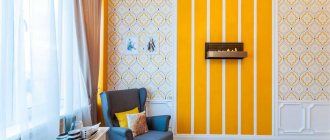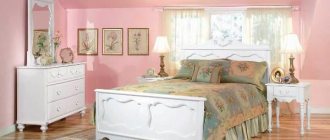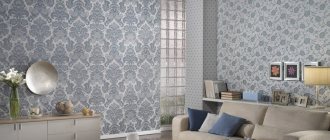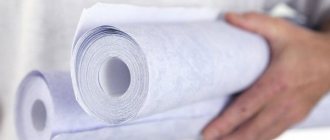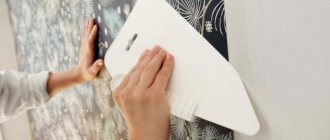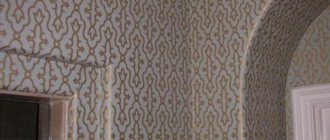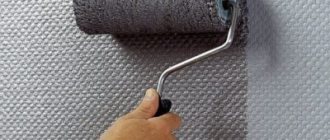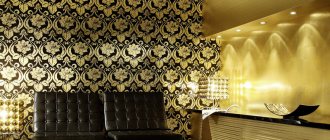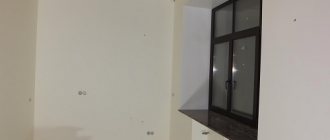Cork wallpaper is not only a cozy decor in eco-style, but also good protection against noise. What is unique about cork wallpaper is that it is 100% natural. They are made from the bark of the cork oak tree, and this bark is removed only once every ten years. After removal, the bark is crushed and applied to a suitable base - usually non-woven material, but simply thick paper is also used.
Cork wallpaper in the interior
For fans of eco-style, cork wallpaper is just a real find. Ecostyle stands for natural colors and materials in the interior, and cork wallpaper is two in one. If you look at the photo you can see how incredible they look.
Designers believe that such wallpapers create an atmosphere of peace and tranquility, and advise those who live in a metropolis to choose this wallpaper. It's like a relaxing effect that residents of cities with a frantic pace of life need.
Cork wallpaper is very warm, wear-resistant and not afraid of moisture. A lot of positive qualities make it possible to use them in any room
Rooms where you can use cork wallpaper:
- Cork wallpaper in the kitchen interior . If you use furniture in natural shades, such wallpaper will be very harmonious. If your kitchen is small, then you can use wallpaper in the form of tiles to cover the walls; the fit will be optimal. If the wallpaper is not impregnated with wax, it is also not suitable for the kitchen - the smells of oil and food will be absorbed.
- Cork wallpaper in the interior of the hall . The walls in the hall or hallway are finished only with materials that can be easily washed and cleaned. Since cork wallpaper is antistatic, dust will not stick to it. This means that such wallpaper can be washed.
- Cork wallpaper in the living room interior . Typically, designers agree that the central wall can be covered with contrasting wallpaper, and the other three with cork. Cork is not always suitable for all four walls, but in this combination it looks great. The color of contrasting walls can be, for example, chocolate.
- Cork wallpaper in the bathroom . For those who are tired of cold tiles. Cork creates the illusion of warmth, which is often lacking in the bathroom. Rest assured that cork is resistant to mildew, mildew and other side effects of high humidity.
Related article: Dimensions of geysers
Cork in the interior can be used as a decorative panel or completely functional wall panels
In general, it can be noted that cork is a fairly versatile material, which, due to its naturalness, looks great in any room. On any wall they can be organic to other interior elements.
Design of rooms with cork wall covering (video)
History of creation
This finishing material has recently entered the construction market; despite its environmental friendliness, it is expensive and has specific colors that are not varied. The advantage of this material is considered to be low thermal conductivity; with such a coating it is easier to maintain a stable temperature background in the room. They are characterized by a high degree of noise insulation, which is important for residents of apartment buildings, because the noise of neighbors is disturbing and annoying. Another property of cork wallpaper is resistance to moisture, so this material is used for finishing rooms with high humidity, including kitchens, bathrooms, and toilets.
Decoration with cork wallpaper
Such wallpaper does not get wet, is not destroyed by water, and does not absorb odors, which is important if there is an animal in the house. Another interesting property of the material is that it is antistatic, because walls covered with wallpaper will be able to repel dirt, particles of dust, and grease, which makes it easier for the apartment owner to care for them.
Cork wallpaper in the hall
Cork does not burn, it is easy for it to smooth out small defects on the walls, and is easy to install. Such a coating is durable if it is used wisely, without scratching with sharp objects or pushing through. There are practically no disadvantages to cork wallpaper; among the few disadvantages, the high price for the material and the small number of shades stand out.
Cork wallpaper in the bedroom
Is it possible to glue cork wallpaper onto wallpaper?
What is important is not the fact that the wallpaper is pasted, but the ideal readiness of the walls for gluing. It doesn’t matter whether you bought wallpaper in rolls or in tiles, you still need to stick it on a flat wall.
How to glue cork wallpaper - technical instructions:
- Walk along the wall with lighthouse starting putty or plaster;
- Next, the surface needs to be primed, and all defects in the walls must be repaired;
- It is impossible to bend cork wallpaper, as well as to glue it overlapping, but only end-to-end;
- You need to cut the wallpaper with strong scissors;
- Before gluing, the wallpaper is cut into strips; you need to let them rest before it comes to pasting the walls;
- Markings on the wall are mandatory - draw a vertical line, glue from it in both directions so that the cutting is the same on all sides.
No glue is used to make such a fabric, since the cork itself releases adhesives during pressing.
If you look at the reviews, it becomes clear that the choice of glue is of great importance.
The main advantages and disadvantages of cork wallpaper
In modern interiors, more and more preference is given to natural materials.
When decorating walls, designers often use cork wallpaper. This natural material, unique in its qualities, has the ability to create a cozy and comfortable atmosphere not only in the home, but also in office spaces. Cork goes well with stone and wood finishes and is suitable for creating a wide variety of styles - from rough country to exotic Japanese and Mediterranean interiors. Let's consider the pros and cons of using cork wallpaper, as well as all types of products for decorating walls made of this material.
Cork wallpaper glue
There are also some nuances here. You can buy expensive acrylic glue, it is easy to use, and a person inexperienced in repairs can figure it out. But experts advise buying simple contact adhesive; you will have to tinker with it, but the wallpaper that is attached to it will definitely never come off.
Just don’t use absolutely any contact adhesive. The packaging should say “for heavy wallpaper.”
Contact glue will work better if you press the wallpaper longer against the wall surface
Related article: Connecting and extending hoses
Do not use PVA glue or other adhesives that contain water. Nitro glue is also not recommended; it is unsafe for human health.
Pros and cons of cork wallpaper
The main obvious advantage of cork wallpaper is its naturalness and environmental safety. Cork wallpaper consists of wood and natural resins obtained by heating and pressing wood chips. The absence of chemical components allows the use of cork wallpaper in the apartment of an allergy sufferer and in a children's room. Other advantages of cork wallpaper include:
- High rates of sound insulation and thermal insulation, wallpaper maintains a comfortable indoor microclimate.
- They do not require maintenance or washing, thanks to a special wax impregnation - they are antistatic and do not attract dust and dirt.
- Cork is a breathable material; in addition, it has antiseptic properties, which prevents the formation of mold and mildew, the appearance of insects and other dangerous microorganisms.
- Cork is not afraid of ultraviolet rays, does not fade or change shape when exposed to the sun.
- The material is coated with special impregnations that protect the cork from burning.
- The natural appearance will resonate with every buyer. In addition, natural material will fit perfectly into any style.
However, it is important to remember the disadvantages of cork wallpaper. The use of cork wallpaper requires high-quality preparation of the base. The choice of color palette is limited; the wallpaper is presented in natural shades of wood. The coating is not protected from mechanical stress; covering a children's room is not justified due to the possibility of damage to the cork. But the main disadvantage of cork wallpaper is the high cost of the material.
You may find it useful
Cork backing for wallpaper
What is a wallpaper backing - it is a canvas that is used as a middle layer. The middle layer means a material whose task is to level and increase adhesion (adhesion) between the wall surface and the finishing coating.
Why is such a layer needed:
- It perfectly compensates for all base defects;
- Serves as a material for additional adhesion;
- Helps quickly prepare the wall for gluing.
In addition to all the above qualities, cork backing is also an excellent insulation material, as well as a sound insulator.
A cork backing is not used only if the topography of the wall protrudes strongly forward.
If you look at the photo of the cork backing, you will see that it is very attractive in appearance; it is often used as a self-sufficient finishing material.
There are regular substrates, without additional properties. But there are also substrates that “know how” to dampen vibrations and are sound insulators.
Cork backing (video)
Features of cork coatings
Let's look at the pros and cons of this group of products, and also look at the main varieties found on the market.
Advantages and disadvantages
Let's start with the main advantages:
| Illustration | Description |
| Authentic appearance . This finish looks unique and cannot be confused with other options. Thanks to the natural texture, a cozy atmosphere is created in the room. |
Thanks to these properties, cork creates a comfortable indoor microclimate.
It must be remembered that the properties of the coating depend on its thickness. The larger it is, the better all the benefits of this solution will be felt.
The disadvantages include poor resistance to deformation and a considerable price for high-quality product options.
Types of material
Let's figure out what types of cork wallpaper for walls there are. There are several main options:
- Cork panels , also called sheets or tiles. Most often, the elements have a size of 300x300 or 600x600 mm, but there may be other options. The main manufacturing material is cork granules, which are pressed under high pressure; for reliability and color preservation, the surface is treated with wax. The thickness can be different, in the standard it is 3 or more millimeters;
The guaranteed service life of this option is from 10 to 30 years
- Cork rolls for walls are a simpler solution in terms of the fact that you have to make much fewer joints. The material has a standard width of 50-100 cm, length is usually 10 meters. Products in rolls can have different textures and colors, so you need to pay attention to this aspect, the thickness can be 2 or more millimeters, thinner options should not be considered, since they are not very durable;
This option looks good in the interior
- Self-adhesive elements resemble cork panels. But unlike the first option, they have a layer of glue on the back side, and to secure the finish, you need to remove the protective layer and press the cork to the surface. This solution is not very convenient to use, since if you glue a piece crookedly, then tearing it off and re-gluing it again is not very convenient;
Self-adhesive coating options
- Paper wallpaper under cork . More precisely, this is an option in which a thin layer of cork material is glued onto a paper base. The main advantage of this solution is the low price and the ability to choose options in different colors, since the base can be painted in different colors, and sometimes cork granules are also painted. But the most popular are still natural colors;
Paper based products
- Cork backing on the wall instead of wallpaper is also used by some people who want to save money. Yes, the costs will be minimal, but the reliability of the coverage will most likely disappoint you. The material crumbles and does not have the most attractive appearance; defects are often found on the surface, since this option was not originally intended for finishing.
Cork backing - it doesn’t fit very well under wallpaper
Self-adhesive cork wallpaper
Self-adhesive cork wallpaper is an innovation in renovation. What’s so great about them is that they stick to the wall just like the more familiar self-adhesive film.
Imagine: the walls to be glued are smooth, clean, even. You have measured them and start cutting the sheets. Along the width of the wallpaper, you need to separate a three-centimeter protective layer. The open part of the wallpaper is glued to the wall, and the protective film is removed from the entire canvas, the sheet is glued completely.
If bubbles have formed under such wallpaper, this can be eliminated with a damp cloth. If the air still does not come out, you can make a small puncture with a needle, and then iron the wallpaper again with a cloth.
The self-adhesive type of cork wallpaper has a particularly thin structure, making it more versatile: it can be used to cover walls, doors, decorate furniture, design panels, etc.
Related article: Shower stall without a roof
Features of gluing
When gluing cork wallpaper, it is important to use the correct adhesive, the same as for bamboo wallpaper. They are quite heavy and experts recommend using glue for cork or heavy paper-based wallpaper.
Sequence of work
- Before gluing, you need to prepare the surface.
- For a high-quality result, it must be clean, dry and even, since the slightest bulges will be clearly visible under the cork wallpaper.
- Cork wallpaper is glued end-to-end and nothing else.
- When using rolls, it is better to make a vertical marking on the wall with a line, from which the strips are glued one after another.
- To apply sheet wallpaper, you need to apply vertical and horizontal markings to the wall.
- To make the seams less noticeable, you need to apply a little glue with a thin brush in places where the edge is poorly set, and then use a roller to process the seams.
- You need to be very careful when gluing the wallpaper in the corners; do not press the wallpaper into the corner, as the cork may crack when the wallpaper is bent.
If you chose this type of wallpaper and took into account all the recommendations when gluing, you will end up with a stylish, practical and modern wall covering that is easy to care for and can even be used in the kitchen.
Popular brands of cork wallpaper
There are several brands that get the best reviews. One of these is Ibercork. Typically, such wallpapers have light colors - beige, yellow and their shades.
Cork wall coverings from the best manufacturers can be found in the Leroy Merlin network of construction hypermarkets.
Sometimes such wallpaper is coated with colored or neutral varnish
Wallpaper from traffic jam in Leroy Merlin:
- They are sold both in the form of cork tiles and in the form of rolls.
- Cork tiles typically weigh 3.3 kg. But only the heavy weight can be considered a drawback; the performance characteristics of the tiles are excellent.
- Cork rolls in Leroy Merlin are not electrified, which means they are not afraid of dust, bacteria or microbes.
Leroy offers many colors and shades from leading manufacturers on the world market, which, of course, makes this coating more attractive to choose from.
Where are cork ceilings made?
Ceiling slabs, which can be bought at the Leroy Merlin hypermarket, are suitable for finishing the ceiling surface in any facility. The building material is usually found in a white shade, but other colors are also available. The panels (slabs) are quite thin. They have an unusual texture and a pleasant natural shade. Not long ago, collections of ceiling and wall coverings in pastel shades appeared, which are great for decorating homes, including bedrooms.
For finishing rooms with the highest level of humidity:
- Kitchen;
- Bathroom;
- Pool.
You should choose special cork slabs that are treated with a wax composition. But such building material can rarely be found in stores, so if you can’t find it, you need to cover the cork surface with colorless varnish - in one layer. Cork panels are attached using “Moment” glue (a type intended for cork) or “Nairit” glue. Despite the fact that the tiles adhere well to glue, it is still recommended to mount them on a frame made according to the same principle as for current Armstrong panel structures.
It is more difficult to make cork ceilings with your own hands, since this work has its own characteristics. If you are not sure and do not have the skills, you should turn to professionals. Cork ceilings are becoming more and more fashionable, which is understandable - they are a reliable and durable finish.
Cork wallpaper in the interior (photo)
What types are there?
On paper or non-woven basis
The most common type of cork wallpaper. The material does not cause difficulties during repairs and has a relatively low cost compared to slabs and rolls. Like other types of wallpaper, in this case there is a base on which oak veneer is applied after going through the preparation procedure.
Self-adhesive
The coating has a base of adhesive paper and a protective film. The cork is applied directly on top of the paper. This type of coating greatly simplifies the work. When finishing, you should be especially careful when applying the canvas to the surface of the walls and accurately measure the joints, since there will be no opportunity to make adjustments.
In addition to walls, self-adhesive wallpaper can be used to decorate door and window openings or update furniture.
Without base
The most environmentally friendly, but at the same time very fragile material. The base performs a connecting and strengthening function; this type of canvas does not provide it. The coating is made from compressed pieces of tree bark, which are glued together with a substance released when heated.
Liquid
Liquid cork wallpaper is packaged and sold in the form of a mixture that consists of oak bark chips and an acrylic-based substance. This type of decoration can decorate the interior and exterior of a building.
The composition is applied to the wall with a spatula or spray, the tool is determined by the desired final effect.
The photo shows a children's room with a classic design. The decoration and filling of the room is designed in warm colors from light beige to brown.
